No, seahorses don’t have teeth and stomachs. The absence of teeth and stomach in seahorses results in unique feeding habits, digestive systems, and diet habits. They eat constantly and digest quickly to survive. Such unique characteristics make these creatures different from other marine species.
The body and metabolic functions of seahorses are evolved properly to adapt to this uniqueness. These unique natures sound amazing, right? You will be more amazed when you go deep into these characteristics. Let’s dive deep to learn more about seahorses’ eating and digesting systems.
Does A Seahorse Have Teeth and A Stomach?
Seahorses have adapted themselves in such a way that they don’t need teeth and stomachs to survive. They evolved to retain all essential nutrients from their food without any presence of the stomach to store and digest them.
Seahorses have long snouts protruding from its head. This snout is responsible for giving it a horse-like appearance but without any teeth. They use their snouts for hoovering up their food as they don’t consist of any teeth.
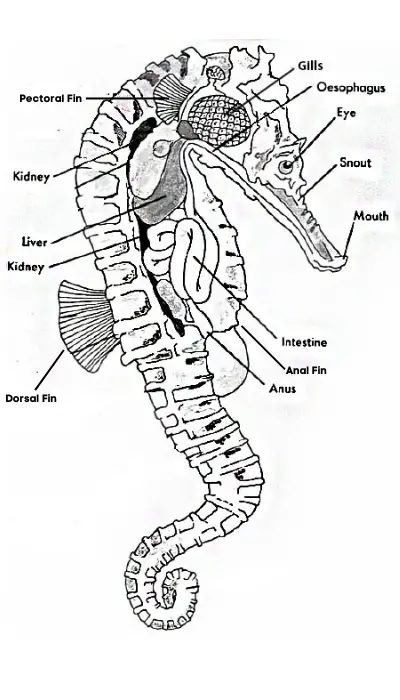
Again, seahorses indeed have a belly. But they don’t have any actual stomachs. Numerous types of stomachs are present in animals, and they also function in different ways.
But, seahorses have no dedicated organ for the digestion of food. That’s why they have to rely on their intestines for digestion and absorption of nutrition.
Moreover, Seahorses eat lots of small shellfish. The shells of these fishes are rich in calcium carbonate. Nonetheless, this calcium carbonation will actively neutralize the acid in the stomach.
Then, the stomach can’t help in the protein breakdown of food. In this case, the stomach proves unnecessary. That’s why seahorses are perfectly fine without a stomach.
Why Don’t Seahorses Have Teeth?
On the way through evolution seahorse lost its genes relevant to growing teeth. They don’t have the genes for enamel proteins. Hence, they don’t possess any mineralized teeth.
The main function of teeth would be attacking prey and mastication. But seahorses have a unique way of attacking their prey and breaking down food.
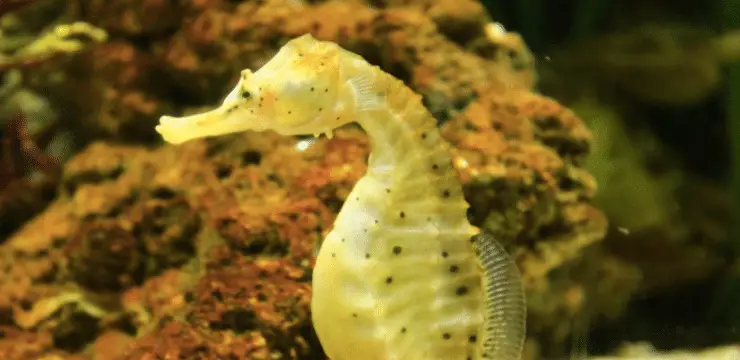
They move their head up and down to create a “No wake zone” for their prey and then suck those tiny prey with the help of their snout.
Furthermore, they also can rotate their necks like spring. This method is called pivot feeding. Also, all food starts to disintegrate after entering the snout. Therefore, they do not face any issues for not having teeth.
Why Don’t Seahorses Have Stomachs?
Seahorse belongs to Genus Hippocampus. One of the most important characteristics of animals of this scientific Genus is that “they don’t have any stomach.”
As a species of the Hippocampus genus, seahorse also doesn’t consist of any stomach. Indeed, a seahorse doesn’t have the gene for this feature.
The absence of a stomach is related to its microphagous eating habits. If you don’t know what microphagous eating is, then let me tell you, it’s the habit of eating small habitats of the sea.
The main function of the stomach is to produce an acidic environment to deform the large food molecules and help break them apart.
Seahorse eats small sea creatures, and its intestine also provides their protein-busting enzyme. Therefore, the stomach in a seahorse is not a mandatory part.
Moreover, they evolved to retain all essential nutrients from their food without any presence of the stomach to store and digest them. For this evolution, they can survive perfectly without the presence of a stomach.
How Do Seahorses Eat Without Teeth?
It is mentioned earlier that seahorse doesn’t have any functional jaws or teeth. That’s why they are unable to chew the food that they eat. As a result, the only thing they can do is swallow the food as a whole.
They have a long snout in front of their mouth. Seahorse uses their snout to suck the food as a vacuum cleaner. As they don’t have teeth, it’s common to assume that they are herbivores. But that’s not true. Although they do eat plants sometimes, they are carnivorous.
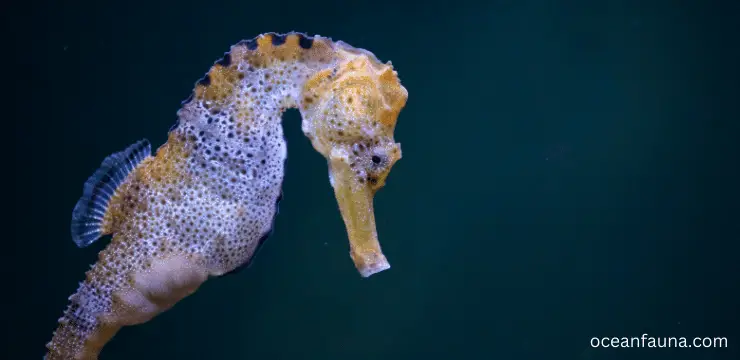
Whereas other fish use teeth to attack, chew and eat their prey, seahorses only use their snout and small toothless mouth. That’s why they can only eat small creatures of the sea.
Mainly, small fishes, planktons, mollies, guppies, and rotifers are on their food list. Precisely, any teeny creatures that float in the water or crawl at the bottom are their potential prey.
How Do Seahorses Digest Food Without a Stomach?
As you know that seahorses don’t have a stomach, you might be thinking that how do they digest food? The answer is very simple. Their digestive system functions in a different way that they don’t need a stomach for digesting food.
As seahorses don’t have any chamber for pre-digestion of the food, the digestion depends on the rest of the digestive system. They have one long tube in their body, which means they have large and extended intestines.
The liver of seahorses has pancreatic tissue. This tissue produces bile acids and also secretes digestive enzymes. As a result, this aids the breakdown and digestion of food. Essential food nutrients are absorbed from digested food when they pass through its long intestine.
Even so, the digestion process proceeds with extraordinary rapidity. As they don’t have any chamber to hold the food, they need to keep constantly eating to be alive. Interestingly, they can eat almost 3000 or more brine shrimp in one day.
How Do Seahorses Poop Without a Stomach?
As seahorses do not have a stomach, they poop in a unique and different way than other animals. When seahorses eat food, it will be digested when it passes through its intestine. All the nutrients will also be absorbed from those digested food in the intestinal tract. After that, the residual food will be counted as waste.
Then this waste will be transported to a small fin. This small fin is located below the abdomen. From there, it will be excreted.
Besides, the Urinary bladder of seahorses also plays a vital role in disposing of waste. It filters out residual unnecessary and harmful material from the blood.
Do Seahorses Bite or Sting?
No, seahorses can’t bite or sting. As they don’t have any teeth, it’s obvious that they are unable to bite or sting.
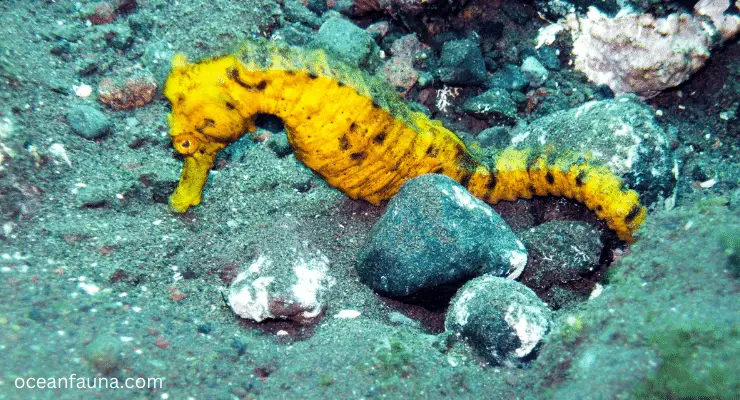
Seahorse floats peacefully through the grass bed and coral reefs. They might not look aggressive, but they are lethal hunters.
Seahorses use their mouth and tubular snouts to catch their prey. They suck their prey into their mouth using their snouts. In a nutshell, they can’t bite or sting, but they can suck.
Can Seahorses Bite Humans?
No, seahorses can’t bite humans. They only can suck in like a vacuum cleaner through their snouts. Seahorses are not aggressive towards humans and rarely pose any threat. They only attack small creatures of the sea in need of food. Besides, seahorses don’t show their attack mood to humans if they are not provoked.
Point to be noted; their suction process may be harmful and life-taking for tiny sea animals. But, to a person, it’s nothing. Therefore, if you find any seahorse, don’t be afraid. First of all, it doesn’t bite, and secondly, seahorses aren’t harmful to you.
But, most importantly, try not to touch the seahorse because you may end up hurting the seahorse, which may provoke them to attack you. The attack might not be fatal, but it can still hurt you.
Verdict
Seahorses have exceptional feeding habits and digestive systems. If you are reading this article from the beginning, I hope you are not confused about whether seahorses have teeth or stomachs.
In summary, they have snouts and quite large and long intestines, which help to make up for the absence of teeth and a stomach. Moreover, Seahorses need to absorb nutrients quickly from food before it is exerted from the body.

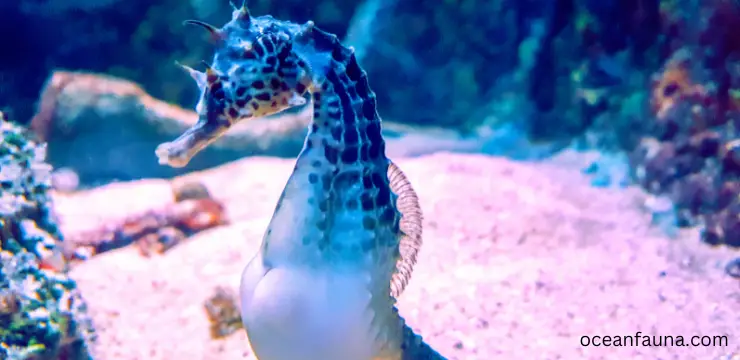
2 thoughts on “Do Seahorses Have Teeth and Stomachs?”